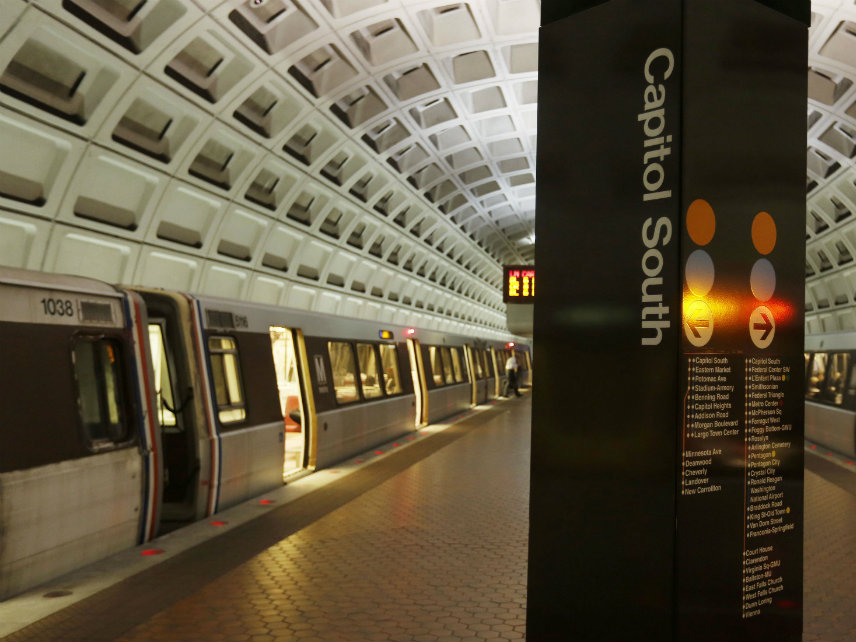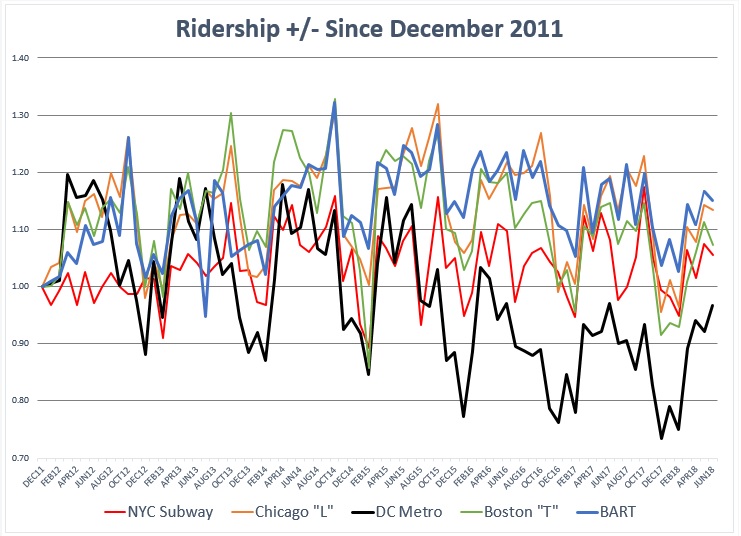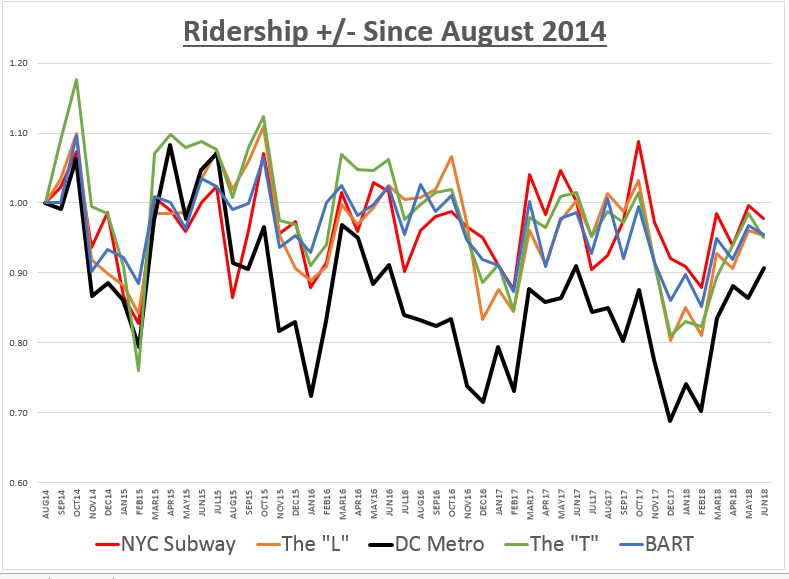Did Ridesharing Kill the D.C. Metro? We Crunched The Numbers.
Other subway systems have managed to maintain or even gain riders since Uber and Lyft launched. Why is the D.C. Metro losing them?

When the city council in Washington, D.C., approved a plan this year to spend more than $178 million in new annual funding for the Washington Metropolitan Area Transit Authority (WMATA), the money had to come from somewhere. To fund the new transit obligations, the city hiked taxes on ridesharing services such as Uber and Lyft by 500 percent, along with more modest increases to the city's general sales and alcohol taxes.
Critics complained that the ridesharing tax was unfair: Why should someone who is choosing not to use the D.C. Metro or WMATA buses have to foot the bill for those services? But the city council claimed there was a causal link between the rise of ridesharing and a decline in Metro ridership. WMATA argued that "dedicated funding" was necessary to replace the user fees lost to the private services.
Ridership numbers from the National Transit Database tell a different story. It is true that ridership on the D.C. Metro has declined since Uber first appeared on the scene. But it is the only one of the country's five largest subway systems to see such a decline since the ridesharing giant arrived in D.C. in December 2011. If ridesharing is killing the D.C. Metro, why have other, similar systems managed to break even or slightly gain riders during the same period of time?

Compared to the New York City Subway, the Chicago "L" train, Boston's "T" service, and the Bay Area Rapid Transit systems—the only other heavy-rail transit systems in the U.S. to provide an average of at least 10 million unlinked passenger trips per month over the past five years—the D.C. Metro seems to have suffered a much more significant decline.
It's fair to question whether December 2011 should be the baseline for this comparison. After all, Uber was more of a premium service when it debuted, and was nowhere near as widely used then as it is now. One could also argue, as WMATA spokeswoman Sherri Ly did when Reason approached Metro with this data, that it's not the launch of Uber that mattered as much as the launch of UberPool, which offers shared rides and significantly lower price points. While Uber and Lyft certainly competed with public transit in their early days, they were (and still are) more analogous to taxi services. It was the advent of pooled rides in August 2014 (both UberPool and Lyft's Line service appeared in the same month) that really allowed ridesharing services to compete on price with mass transit.
So we ran the numbers a second time, using August 2014 as the baseline.

This time, all five major transit systems have lost riders. Still, the Metro is a clear laggard.
In comments to Reason, Ly argues that the ridership decline could have other causes. She points to the fact that it's more common for people to work from home these days, and she notes the rise of alternative commuting options such as bikesharing and rental scooters. But telecommuting and e-scooters are hardly exclusive to D.C., so they don't really answer the question of why the Metro has seen a sharper drop-off than other, similarly sized systems. In any case, the existence of multiple potential causes undermines rather than reinforces the decision to pin the blame on ridesharing and hike taxes on Uber and Lyft users.
And there's another potential culprit here.
"The biggest driver of Metro's ridership decline is Metro itself," says John Kartch, vice president at Americans for Tax Reform. "People have places to go and things to do, and they do not see Metro as reliable, safe, convenient, or even affordable in some cases. People need to get to work on time, and there are only so many broken escalators, long delays, and hot cars they can take before looking elsewhere."
D.C. is hardly the only city with an unreliable public transit system, but there may be reasons why Washingtonians would be quicker to look for alternatives to the subway. A higher concentration of wealth or the geography of the city—the core of Washington is significantly smaller than Chicago or New York—perhaps makes residents of D.C. more likely to hop on an Uber for a short crosstown trip.
Of course, if the city's geography or populace are driving the decline in subway ridership, further investments in the subway are unlikely to lure people back. Instead, it makes the transfer of taxes from ridersharing users to the Metro look like a favor to a well-connected agency.
Ly admits that Metro shares some of the blame. "Metro's year-long emergency safety blitz, called SafeTrack, depressed ridership in 2016 and 2017," Ly tells Reason.
That's an ongoing problem. In fact, Metro actively warned riders not to use the Metro for several weeks this summer, since track work has closed part of two lines and caused significant reductions in service along two others. Trains were running more than 10 minutes apart, even during rush hour.
Those recent closures—along with reduced nighttime and weekend service to allow more maintenance work to be done—have no doubt contributed to Metro's ridership decline. But like the decline itself, they are symptoms of larger problems. Poor planning and years of deferring maintenance on the subway system have forced the WMATA to take actions that further alienate riders and boost alternative means of commuting.
However you want to slice it, those problems are rooted in decisions that WMATA officials made. Does that justify taxing ridesharing services to bail out the Metro?
"WMATA brass and the DC Council think that by virtue of its very existence, Metro is entitled to a certain ridership number," says Kartch. "And that type of thinking leads to the steep ridesharing tax hike imposed by the Council. Instead of improving service, they raise taxes."
The data used for this article can be found at the Federal Transit Administration's National Transit Database here.


Show Comments (55)